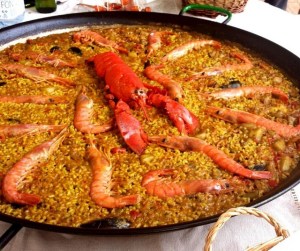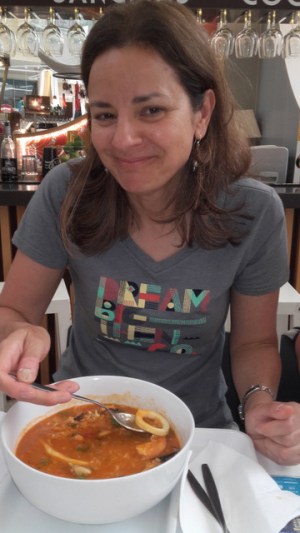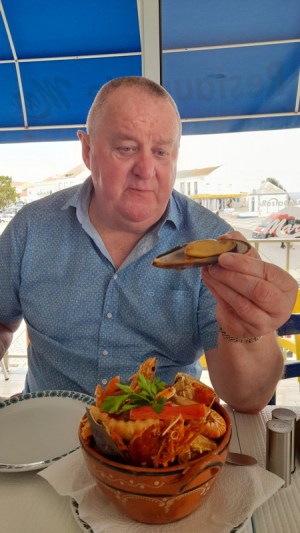Portuguese Seafood Rice
How to make Portuguese Seafood Rice
 Discover the culinary delight of Portuguese Seafood Rice, known as Arroz de Marisco. Renowned for its exceptional blend of healthiness and scrumptiousness, this traditional dish has earned a special place in the hearts of many in Portugal. Whether you are an ardent fan of rice or a seafood enthusiast, this recipe promises to be a delightful and straightforward option for your next meal.
Discover the culinary delight of Portuguese Seafood Rice, known as Arroz de Marisco. Renowned for its exceptional blend of healthiness and scrumptiousness, this traditional dish has earned a special place in the hearts of many in Portugal. Whether you are an ardent fan of rice or a seafood enthusiast, this recipe promises to be a delightful and straightforward option for your next meal.
What is Portuguese Seafood Rice?
Portuguese Seafood Rice is a delectable culinary creation that showcases a rich and flavorful Atlantic Seafood stew combined with rice. This exquisite dish features a medley of delightful ingredients, including succulent cockles, delectable crab, plump shrimp, tender clams, briny mussels, and the option of adding cuttlefish or squid for an added depth of flavor. Seasoned with a harmonious blend of olive oil, salt, pepper, and the distinctive Portuguese chili known as Piri-Piri (Portuguese chili), this dish encapsulates the vibrant and tantalizing flavors of Portugal’s coastal cuisine.
Check out these popular recipes:
- Bifana – Portuguese Pork Sandwich
- Portuguese Steak Recipes
- Portuguese Custard Tarts
- Piri Piri Chicken
What are the differences between Paella and Arroz de Marisco?
Paella and Arroz de Marisco, while both rice-based dishes, possess distinct characteristics that set them apart.
One notable difference lies in the choice of rice. In Portugal, Arroz de Marisco typically incorporates Carolino rice, whereas, in Spain, paella commonly employs Bomba Rice, Valencia rice, or Calasparra Rice.
Another distinguishing factor is the inclusion of specific ingredients. Traditional paella recipes often incorporate chorizo, chicken, and peas, which are not typically found in Arroz de Marisco.
However, the most significant contrast lies in the texture and overall consistency of the dishes. Paella is known for its dry composition, while Arroz de Marisco bears a resemblance to Arroz Caldoso, a Spanish soupy seafood rice. In Arroz de Marisco, the rice is cooked to achieve a sticky, moist texture, immersing it in a flavorful fish stew.
These distinct characteristics ensure that both paella and Arroz de Marisco offer unique and delightful culinary experiences, each reflecting the culinary traditions and preferences of their respective regions.
Read more: Best Time to Visit Portugal.
 How is Portuguese Seafood Rice served?
How is Portuguese Seafood Rice served?
In Portugal, the serving of Portuguese Seafood Rice is a cherished tradition typically reserved for Sunday lunches. These meals hold a special significance, bringing together friends and family to indulge in a memorable culinary experience. To enhance the enjoyment of this dish, it is often paired with a refreshing Sparkling Vinho Verde wine, which complements the flavors of the seafood and rice harmoniously. A generous supply of cornbread is also provided, allowing diners to savor every last drop of the savory sauce, making it an integral part of the dining experience.
How to order Seafood Rice in Portugal?
When ordering Seafood Rice in Portugal, follow these useful tips to enhance your dining experience:
- Inquire about portion sizes: To ensure you receive an appropriate quantity, ask the waiter for details. Some establishments serve Seafood Rice in a single clay pot, which typically serves 2 to 4 people.
- Mindful serving portions: When the dish arrives at your table, start by serving yourself a small tablespoon of rice. It is recommended to repeat this process, taking additional servings as desired. By doing so, each serving of rice will have a distinct texture and flavor. This is because the rice continues to cook within the clay pot, and by pacing your servings, you can avoid overcooking. Keep in mind that if you have leftovers and consume them the following day, the rice may appear slightly overcooked due to the ongoing cooking process in the pot.
By following these tips, you can fully enjoy the flavors and textures of Seafood Rice, ensuring a satisfying and memorable dining experience in Portugal.
Read more: Best Things to Eat in Portugal?
How is Arroz de Marisco made?
Read here the authentic Portuguese seafood rice recipe:
 Seafood Stew Ingredients:
Seafood Stew Ingredients:
- 2 onions
- 3 cloves of garlic
- 1 bay leaf
- bunch of parsley
- 2 tablespoons of tomato paste
- 4 ripe tomatoes
- 1 bell pepper diced
- 1 teaspoon of Piri-Piri
- Salt (to taste)
- Olive oil (to taste)
- 1 1/4 cups rice (250 grams)
- 1 kg of varied seafood (shrimp, cockle, mussels, clams)
- 4 cups of water
Instructions:
In a saucepan with water seasoned with salt and a lot of parsley, cook the shrimp and a small onion.
 Bring to a boil over high heat. When it starts boiling, reduce to low heat and cook for about 5 minutes. When the shrimps are cooked, drain them with a skimmer. We will use the water for cooking the rice.
Bring to a boil over high heat. When it starts boiling, reduce to low heat and cook for about 5 minutes. When the shrimps are cooked, drain them with a skimmer. We will use the water for cooking the rice.
Place the olive oil, chopped garlic, chopped onion, bay leaf, pepper, tomato paste, and the peeled tomatoes cut into small pieces in a saucepan.
Bring to low heat and cook until the tomato starts to break down.
Then, add the rice, cockle, mussels, and clams. They will cook through and open up. If any happen to remain closed, discard them. Season with salt and a Piri-Piri, stir, and cook for about a minute.
Pour the water (twice the rice volume) and boil over high heat. When it starts boiling, reduce to low heat and simmer for about 12 minutes. Start tasting the rice. Adjust for salt and Piri-Piri now.
Add the shrimp already cooked before.
Turn off the heat and sprinkle with chopped coriander and parsley. Serve immediately.
Read more: How can I get to Portugal?
Check out our culinary vacations in Portugal.
 Embark on a captivating journey through Portugal, where a treasure trove of culinary delights, captivating history, and breathtaking landscapes await. Join our small-group tour and immerse yourself in the flavors and traditions that make Portugal truly special. From the charming streets of Porto and Braga to the enchanting beauty of Sintra and Lisbon, every step of your adventure will leave you in awe.
Embark on a captivating journey through Portugal, where a treasure trove of culinary delights, captivating history, and breathtaking landscapes await. Join our small-group tour and immerse yourself in the flavors and traditions that make Portugal truly special. From the charming streets of Porto and Braga to the enchanting beauty of Sintra and Lisbon, every step of your adventure will leave you in awe.
Indulge in the exquisite flavors of Portugal as you discover the secrets of Arroz de Marisco, a mouthwatering seafood rice dish, during our exclusive cooking classes offered by Portugal Food Tours. Learn from skilled chefs and savor the delectable dishes paired with exceptional Portuguese wines, allowing your taste buds to revel in the country’s culinary excellence.
To stay informed about our latest tours, travel tips, tantalizing recipes, and exclusive discounts, sign up for our newsletter. We are committed to providing you with unforgettable experiences and sharing the wonders of Portugal with you.
For a visual feast of stunning photos, captivating videos, and travel tips, connect with Eco Trilha – Portugal Tours on popular social media platforms such as Facebook, Instagram, Pinterest, Twitter, and YouTube. Immerse yourself in the beauty of Portugal even before your journey begins.
Don’t miss the opportunity to embark on a culinary vacation that will leave you with lifelong memories. Book your spot online now, and let us take care of the rest. Portugal is calling, and we can’t wait to share its wonders with you.
